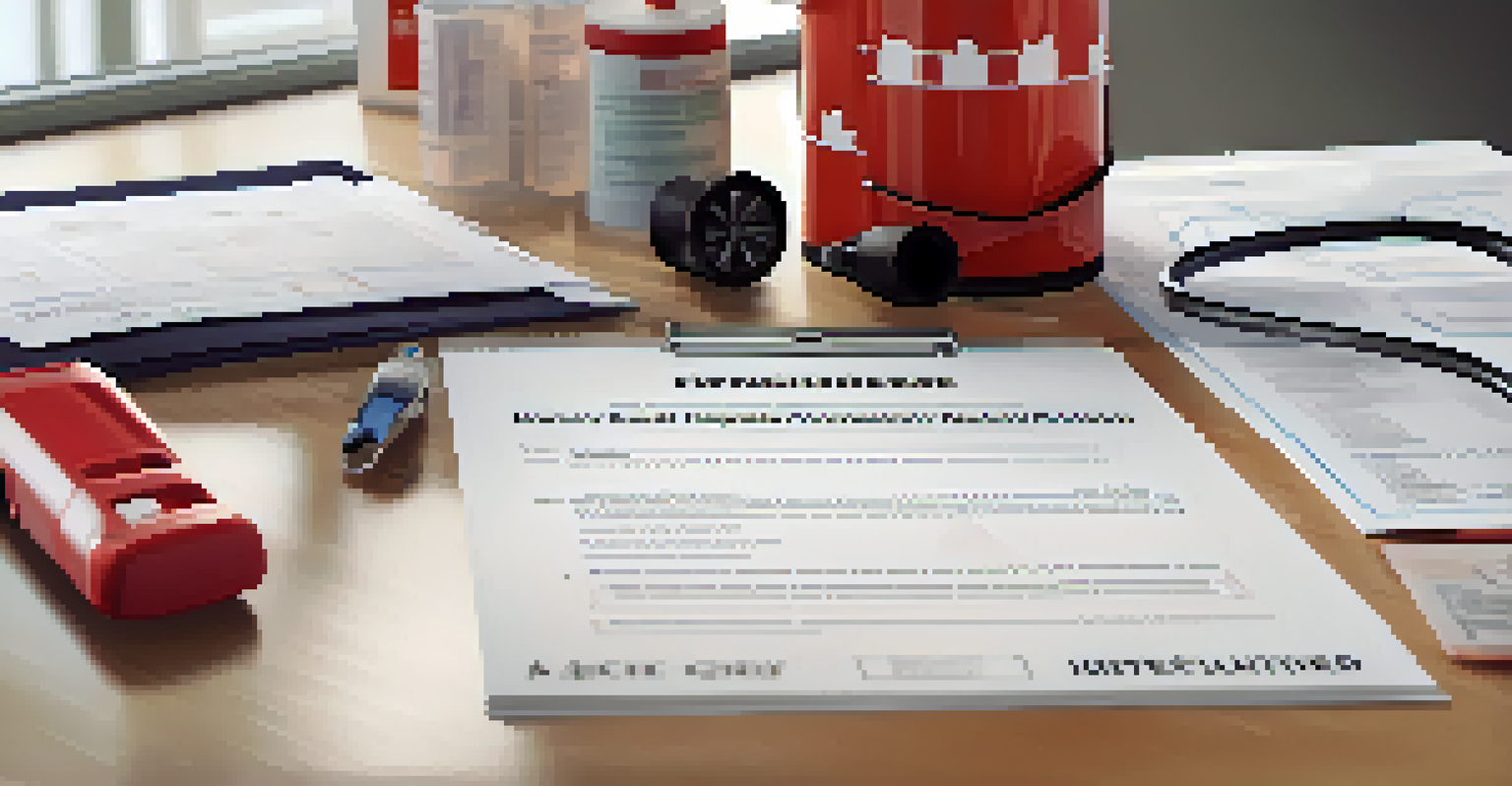Emergency Response Plans: A Key to Workplace Safety

Understanding Emergency Response Plans and Their Importance
Emergency response plans (ERPs) are structured procedures that guide organizations in responding to various emergencies. They are crucial for ensuring the safety of employees and minimizing potential harm during unforeseen events. By having a clear plan in place, companies can act swiftly and efficiently when crises arise.
An ounce of prevention is worth a pound of cure.
These plans cover a range of scenarios, from natural disasters to workplace accidents, and outline roles, responsibilities, and communication strategies. For instance, during a fire, an ERP would specify evacuation routes and assembly points to ensure everyone knows where to go. This level of preparedness can make a significant difference in the outcome of an emergency.
Moreover, ERPs are not just about reacting to emergencies; they also help in identifying potential risks and hazards in the workplace. This proactive approach allows organizations to implement preventive measures, ultimately fostering a safer work environment for everyone.
Key Components of a Comprehensive Emergency Response Plan
A well-rounded emergency response plan typically includes several key components that ensure effectiveness. First and foremost, risk assessment is essential to identify potential threats specific to the workplace. This assessment informs the development of tailored response strategies that address the unique challenges each organization may face.

Next, clear communication protocols must be established. Employees should know who to contact during an emergency and how information will be disseminated. For example, using a designated emergency contact list can help streamline communication and prevent confusion when every second counts.
Importance of Emergency Response Plans
Emergency response plans are essential for ensuring employee safety and minimizing harm during unexpected events.
Finally, regular training and drills are vital to ensure everyone is familiar with the emergency procedures. Practicing these scenarios helps reinforce the plan and makes employees feel more confident in their roles during a real emergency. This ongoing commitment to training contributes to a culture of safety within the organization.
The Role of Training in Emergency Preparedness
Training is a cornerstone of effective emergency response plans. It equips employees with the knowledge and skills they need to act decisively during a crisis. Regular training sessions can cover various topics, such as first aid, evacuation procedures, and the use of fire extinguishers, ensuring everyone knows what to do in an emergency.
Safety doesn't happen by accident.
Moreover, hands-on practice through drills reinforces the theoretical knowledge gained during training. These simulations help employees become familiar with the physical layout of the workplace and the specific routes they should take during an evacuation. This familiarity can significantly reduce panic and confusion in real-life situations.
Additionally, training fosters a sense of teamwork and camaraderie among employees. When everyone is involved in the preparation process, it builds trust and encourages a collaborative approach to safety, making the workplace a more secure environment overall.
Evaluating and Updating Your Emergency Response Plan
An emergency response plan should never be static; it must evolve as the organization changes. Regular evaluations are essential to assess the effectiveness of the plan and identify areas for improvement. This can involve gathering feedback from employees after drills or actual incidents to understand what worked well and what didn’t.
Furthermore, as new risks emerge or the workplace environment changes, the ERP must be updated accordingly. For example, if a new piece of machinery is introduced that poses specific hazards, the plan should include procedures on how to manage emergencies related to that equipment. This adaptability ensures that the plan remains relevant and effective.
Key Elements for Effective Plans
A comprehensive emergency response plan should include risk assessments, clear communication protocols, and regular training.
In addition, involving employees in the review process can lead to valuable insights and foster a culture of safety awareness. When staff members feel their input is valued, they are more likely to stay engaged with the emergency response efforts and contribute to a safer workplace.
Technology's Role in Enhancing Emergency Response Plans
Technology plays an increasingly vital role in modern emergency response plans. From communication tools to monitoring systems, leveraging technology can improve preparedness and response times. For instance, mass notification systems can quickly alert employees about emergencies, ensuring everyone is informed simultaneously.
Moreover, digital platforms can facilitate training and simulations, providing employees with interactive tools to familiarize themselves with emergency protocols. Virtual reality (VR) training can immerse staff in realistic emergency scenarios, enhancing their ability to respond effectively under pressure.
Additionally, data analytics can help organizations track incidents and identify trends over time. By analyzing this information, businesses can make informed decisions about resource allocation and preventive measures, ultimately leading to a safer workplace.
Legal Obligations for Emergency Response in the Workplace
Organizations have a legal responsibility to ensure the safety of their employees, which includes having an effective emergency response plan. Various regulations, such as those set forth by the Occupational Safety and Health Administration (OSHA), mandate that employers assess hazards and implement appropriate emergency procedures. Failing to comply with these regulations can result in significant penalties.
In addition to legal compliance, having a robust ERP can protect organizations from liability in case of accidents. If a company can demonstrate that it took reasonable steps to prepare for emergencies, it may mitigate the risk of lawsuits from employees or clients. This proactive stance not only fosters safety but also builds trust with stakeholders.
Adapting Plans for Continuous Safety
Regular evaluations and updates of emergency response plans are crucial to address new risks and maintain workplace safety.
Ultimately, understanding and adhering to legal obligations surrounding emergency preparedness is not just about avoiding penalties; it reflects an organization’s commitment to the well-being of its workforce. A culture of safety can enhance employee morale and productivity, creating a more positive work environment.
Creating a Culture of Safety in the Workplace
Establishing a culture of safety is crucial for the success of any emergency response plan. When safety is prioritized, employees are more likely to engage with the ERP and take it seriously. This cultural shift begins with leadership setting the tone by actively promoting safety initiatives and encouraging open discussions about potential hazards.
Involving employees in safety committees or task forces can also foster a sense of ownership and accountability. When staff members contribute to safety policies and procedures, they are more likely to adhere to them and help identify areas for improvement. This collaborative approach can lead to innovative solutions that enhance workplace safety.

Additionally, celebrating safety milestones and recognizing individuals or teams for their contributions to safety can reinforce the importance of a safety-focused culture. Acknowledging these efforts not only boosts employee morale but also reinforces the idea that safety is a shared responsibility.